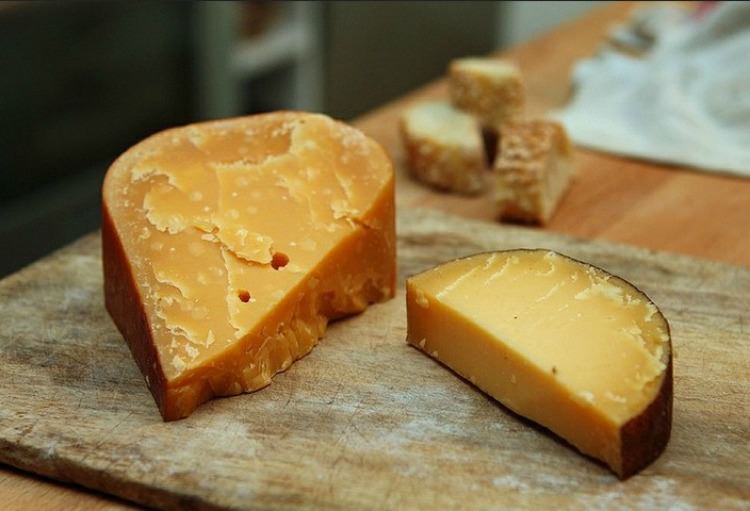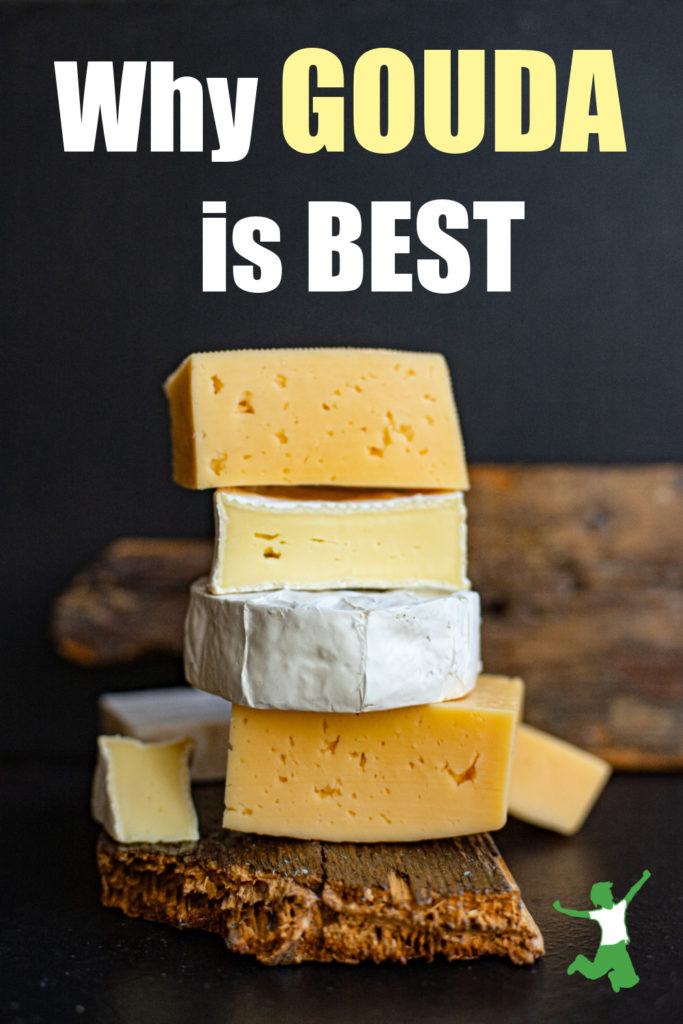Why Gouda is likely the most nutrient dense type of cheese you can buy even if you buy supermarket brands made with conventional milk.

If I was forced to choose a single cheese to eat for the rest of my life that would best maintain my health, it would be Gouda cheese.
Is Gouda my favorite healthy cheese?
Not really.
While I certainly like Gouda cheese and don’t mind eating it, my taste buds consistently rank several other cheeses quite a bit higher on the enjoyment scale such as Brie which I craved during pregnancy.
Why Gouda cheese then?
Gouda and the X Factor
You might be shocked to learn, as I was, that Gouda cheese is higher than most liver, grassfed butter, and even pastured egg yolks in the critical nutrient Vitamin K2.
This is the nutrient identified by Dr. Weston A. Price as the elusive “Activator X”.
Vitamin K2 along with the other fat soluble activators A and D are synergistically responsible for the vibrant health and extremely high resistance to aging and degenerative disease as experienced by Traditional Cultures and as described in Dr. Price’s groundbreaking book Nutrition and Physical Degeneration.
Vitamin K2 is extremely difficult to get sufficient quantities of in the diet. This is the case even if one consumes grassfed meats and dairy on a regular basis.
The reason is the worrisome depletion of our soils which grassfed farmers are valiantly turning the tide on, but which will still take several decades if not even a century or two to reverse on a widespread basis.
On top of this, many families are currently struggling to afford any grassfed meat and dairy at all.
An inflationary economy requires creative and practical solutions for the food budget. This ensures that this critical and elusive nutrient is in the diet in sufficient quantities.
This helps secure freedom from tooth decay and high immunity. Such vigilance prevents degenerative diseases like osteoporosis, cardiovascular disease, periodontal disease, cancer, and diabetes among many others.
K2 is also the vanity vitamin as it is known to prevent facial wrinkles. K2 deficiency can be written all over your face…quite literally!
Synergy with No Toxicity
Vitamin K2 has no known toxicity even at high intake levels.
However, it is most effective when consumed in the presence of the other fat soluble activators Vitamin A and D.
Therefore, getting Vitamin K2 from food is always the best way to go if at all possible.
Gouda Cheese Top 3 for Most Elusive Nutrient
This is where Gouda cheese comes in.
You see, the food that is highest in Vitamin K2 is natto, which is very difficult to find and even more difficult to consume due to its very horrible taste and texture. If you are game, you can usually find it at Asian specialty stores. Look for it in the freezer section.
Natto contains about 1,103 mcg of K2 per 3.5 ounce portion. This is more than any other food by a large margin. Note that it is best to source organic natto due to toxicity issues from GMO soybeans.
The second highest food in Vitamin K2 is goose fat particularly from the liver which has 369 mcg per 3 1/2 ounce portion.
While highly delicious and wonderful to eat, goose liver pate is very hard to find in most places. It is also a very high end, gourmet food which makes the price out of reach for most.
Rounding out the top 3 foods highest in Vitamin K2 is none other than the humble Gouda cheese. It boasts 75 mcg per 3 1/2 ounce serving! This compares to pastured egg yolks and butter, which each have about 15 mcg of K2 per 3 1/2 ounce portion.
Grassfed or Organic Not Required
Here’s the really excellent news…
Gouda cheese is extremely high in Vitamin K2 even if the milk it’s made from was not grassfed.
This is due to the bacterial cultures used to ferment milk into Gouda cheese. Bacteria produce a special type of Vitamin K2 (MK-7) which according to current research is as effective as the animal form of Vitamin K2 (MK-4) at preserving human health when combined in the diet with the other fat soluble activators A and D.
Of course, grassfed Gouda cheese would be best as Gouda made from this highest quality raw milk would be high not only in MK-7 but also MK-4, the animal form of K2.
For some, however, supermarket Gouda cheese is all they can find or afford!
In other words, Gouda cheese is high in Vitamin K2 regardless of how the milk was produced. Gouda even if made from the milk of the average grainfed, conventionally raised cow, is still very much worth it to buy from a nutritional standpoint!
Other hard cheeses would also be high in Vitamin K2, but Gouda is the highest of them all. Perhaps this is a reason why cheese is the most stolen item in the world!
Sources
Vitamin K2 and the Calcium Paradox, by Dr. Kate Rheaume-Bleue ND









Does young Gouda have vitamin K2?
I don’t like aged gouda. I somwhat like the flavor of aged gouda but I strongly dislike the texture. It’s like eating earth! Maybe it was a bad batch?
About MK4 and MK7, they are good because they start a ‘chain reaction’ of some proteins that actually regenerate the bones (even teeth) and remove calcium plaque from arteries and even help preventing kidney stones. So, it turns out the is the one that heals itself, but it needs a little push in the right direction, and that is why bacteria poo is good for you.
Natto is a great source of K2, however it does smell really bad and you really have to dress it up. Why do you think Japaneese people have slanted eyes? It’s caused over generations from eating this stuff and smelly fish. They grimace when they eat. Gouda doesn’t smell; hence, Europeans don’t have slanted eyes. This is my theory. I know it’s not scientifically proven yet, but it makes sense if you think about it. Anyways I don’t want to contort my face just to live an extra year or two. So I’m Gouda stick with the cheeses. Gouda nuff for me.
Malcolm M,
You Not funny, and your Not Cleaver.
I think that is a Raciest statement, and it comes from Ignorance.
Oh good another professional victim looking for something to be offended about.
Learn how to recognise a joke
wow, so anything and everything distasteful is just a “joke”?
learn how to recognize good natured jokes from ones that are thinly disguised to offend and then call anyone who calls them out on it as trying to be a victim.
It would be pretty safe to say that imported Gouda, rather than domestically (US) produced Gouda is made with milk from grass-fed cows, as most cows in the Netherlands enjoy pastures year-round.
Technically, if a cheese is called Gouda it must be from Holland. dutchnews.nl/news/archives/2010/10/european_commission_confirms_p/.
However, it is possible to find cheeses that are called “Gouda” from other places.
That’s why I always look on the label.
First, I don’t want to support an unethical company that isn’t respecting the right of Holland to be the only source of Gouda. That’s like France and Brie cheese. The consumer should be able to trust the label.
Next and even more important, I don’t want to eat grain-fed cheeses, even if they have some K2, they won’t have as much as cheeses that are from fully-pasture-raised grass-fed cows AND the other fats and nutrients are tilted towards more cancer, cardiovascular disease and a shorter lifespan, according to Harvard researchers.
michaelmooney.net/HarvardSaysEatRedMeatandDie.html
There’s something like as much as 50 times more K2 in fully grass-fed dairy compared to grain-fed dairy, regardless of other considerations.
Even if it weren’t the best it would still be my favorite till they bring my Belgian cheese to market . That just melts in the mouth just as our chocolate does .
Lol, I forget that it’s good for you! The taste outweighs the benefits, lol!
Does melting or putting cheese in casseroles effect the K2?
That’s good news
Always was my favorite.
What about the hormones and antibiotics in non-grassfed Gouda? I love gouda but cannot find it organic.
young gouda is the cheapest cheese in germany – weak quality – i guess, it depends on the ingredients, how good they are…